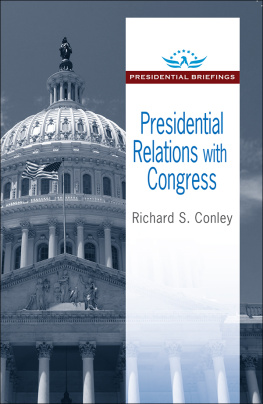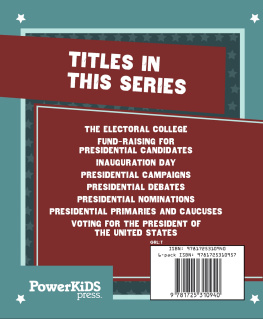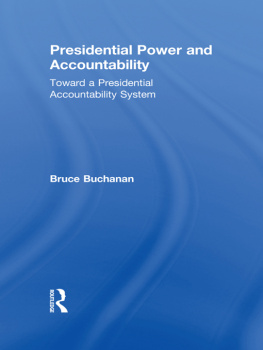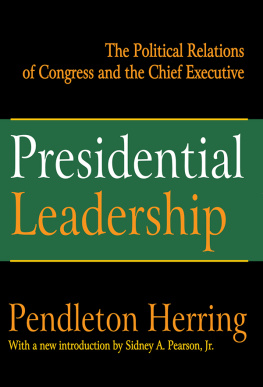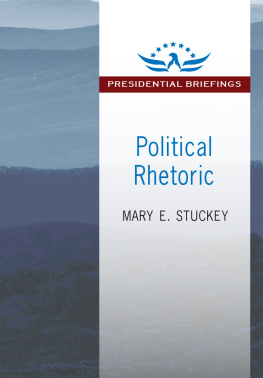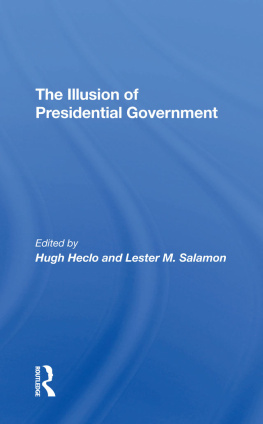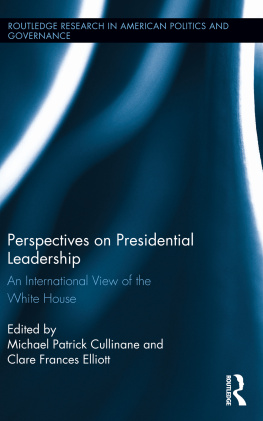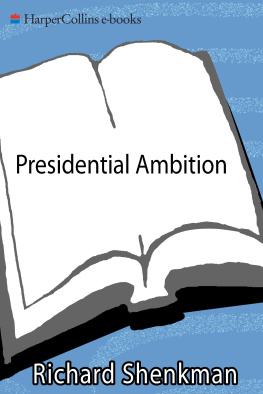Presidential
Relations with
Congress
The Presidential Briefings Series
Robert J. Spitzer, Series Editor
The Presidential Briefings Series provides concise and readable introductions to topics of concern to those who have been and will be President of the United States. By approaching their subjects from the vantage point of what a president most needs to know, and what the citizenry most need to know about the presidency, these books are authoritative and significant works on subjects related to the presidency.
Previously published and forthcoming works include:
Political Rhetoric by Mary E. Stuckey
Making Foreign Policy Decisions by Christopher J. Fettweis
Presidential Leadership in an Age of Change by Michael A. Genovese
Picking Judges by Nancy Maveety
Presidential Relations with Congress by Richard S. Conley
Presidential Success: A Practical Guide by Stanley A. Renshon
PRESIDENTIAL BRIEFINGS
Presidential
Relations with
Congress
Richard S. Conley
First published 2017 by Transaction Publishers
Published 2017 by Routledge
2 Park Square, Milton Park, Abingdon, Oxon OX14 4RN
711 Third Avenue, New York, NY 10017
Routledge is an imprint of the Taylor and Francis Group, an informa business
Copyright 2017 by Taylor & Francis.
All rights reserved. No part of this book may be reprinted or reproduced or utilised in any form or by any electronic, mechanical, or other means, now known or hereafter invented, including photocopying and recording, or in any information storage or retrieval system, without permission in writing from the publishers.
Notice:
Product or corporate names may be trademarks or registered trademarks, and are used only for identification and explanation without intent to infringe.
Library of Congress Catalog Number: 2016026185
Library of Congress Cataloging-in-Publication Data
Names: Conley, Richard Steven, author.
Title: Presidential relations with Congress / Richard S. Conley.
Description: New Brunswick, New Jersey : Transaction Publishers, 2016.| Series: Presidential briefings series | Includes bibliographical references.
Identifiers: LCCN 2016026185 (print) | LCCN 2016045383 (ebook) | ISBN 9781412864350 (hardcover : acid-free paper) | ISBN 9781412864411 (pbk.: acid-free paper) | ISBN 9781412864503 (ebook) | ISBN 9781412864503
Subjects: LCSH: Presidents-United States. | United States. Congress. | Political planning-United States.
Classification: LCC JK585 .C68 2016 (print) | LCC JK585 (ebook) | DDC 328.73/07456--dc23
LC record available at https://lccn.loc.gov/2016026185
ISBN 13: 978-1-4128-6441-1 (pbk)
ISBN 13: 978-14128-6435-0 (hbk)
To my beloved father, Jerry Steven Conley
Navy man, rock hound, adventurer, and exceptional grandpa
"We have an unknown distance yet to run, an unknown
river to explore. What falls there are, we know not; what
rocks beset the channel, we know not; what walls ride
over the river, we know not. Ah, well! We may conjecture
many things."John Wesley Powell
Contents
An oft-cited metaphor about dynamics on Capitol Hill is that trying to lead Congress is like herding cats. Indeed, from their vantage point in the Oval Office modern presidents must sometimes feel like the poor fellow in a recent television advertisement who is sinking in desert quicksand under the watchful eye of an indifferent feline. The four-legged misanthrope, mel-ancholically wagging its tale next to the pit, is seemingly as full of contempt as apathy for the despondent man's misfortune. He implores the cat to go get help as a highway full of cars is visible close by, but the temperamental mouser just stares unflappably at the doomed anti-hero. The advertisement underscores the importance of insurance when calamities strike. But for the American chief executive there is no policy that can be purchased to insure a majority in Congress, the cooperation of legislators on either side of the aisle, or ultimately legislative success.
One reality of the American political system is that muchif not mostof what presidents wish to accomplish in policy terms requires congressional assent. Unilateral actions, notwithstanding the president's role as commander in chief, require an existing statutory framework for executive orders. The other, perhaps more stark reality is that the constitutional separation of powers imposes a unique set of constraints on legislative leadership not found in many other Western industrialized democracies. In parliamentary systems like Canada or Great Britain that rely on the Westminster model of governance, prime ministers are "first among equals" and alongside cabinet members direct the lion's share of the legislature's business by fashioning policy proposals that are subsequently sent to the parliament for ratificationwhich is all but assured with a typical majority government in which party discipline is expected and enforced.
Such a "top-down" policy process is inverted in Washington. As the saying goes, "Presidents propose and Congress disposes." American presidents rarely direct the legislative process. Rather, as George C. Edwards (1989) accentuates, they must find ways to facilitate it. The president has to locate (and sometimes cajole!) a member of Congress to introduce a bill on his behalf. But that is just the beginning of a long, often arduous process. Unity in the president's party can never be taken for granted. Moreover, the proposal may be challenged or superseded by legislation sponsored by other members. Further, the proposal may be subject to a host of proposed amendments or alterations in a bicameral environment that, in the final analysis, may render the president's objectives unrecognizable upon passage. Even when Congress is controlled by a majority of his own party, the president's success is scarcely guaranteed. Members may introduce their own bills that run counter to the president's policy objectives. Finally, the frequent condition of "divided government," in which the opposite party controls Congress has proven increasingly aggravating for chief executives in an era of growing institutional partisanship and ideological polarization. The majority may declare the president's agenda "dead on arrival," supplant the president's policy goals, and force showdowns dominated by the only major constitutionally enumerated legislative tool at the president's disposal: The veto power, and by extension, veto threats.
This briefing book is an epistemological exercise with respect to the legislative presidency. What do scholars know about the factors that contribute to presidential success or failure in dealing with Congress, and how can we account for the wide variation in post-World War II presidents' interactions with members on Capitol Hill? Our quest must commence with an understanding of the "bargaining," "institutional constraint" (Congress-centered), and "personality" perspectives on presidential legislative leadership. The larger analysis spans presidential agenda and roll call success to Supreme Court nominations. It is critical across our analysis to grasp the impact of organizational reforms and internal dynamics in Congress, differences in domestic and foreign policy contexts, and other factors such as electoral conditions in order to assess variation in presidential strategies over time. Let us commence our journey through the lens of theories that have guided scholars in the bid to assess the nature of presidential leadership of Congress.

